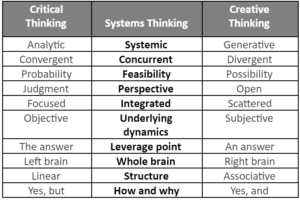As you know if you’ve read any of my recent posts, systems thinking balances critical thinking and creative thinking by providing context and perspective. But what does that mean in practice? How can we maximize critical and creative thinking as leadership development consultants, or in any aspect of our daily lives for that matter?
In the table shown below, I’ve added a middle column between critical and creative thinking that provides guidance for using systems thinking to balance critical and creative thinking. Thinkers may gravitate to the left or to the right, but the goal is to return to the middle to keep thinking in balance. This balance should also allow thinkers to respond more quickly to certain situations.

Though systems thinking is a natural approach, it initially can be a difficult concept for many people to grasp—and for good reason. A lifetime of learning what to think makes any other way of thinking feel uncomfortable and challenging.
Take project management as an example. In my experience, the traditional profession of project management often adheres to something resembling nineteenth-century industrial production thinking. High-level project management consists of planning, budgeting, resourcing, scheduling, managing, verifying, and closing, all wrapped in documentation, rules, and checklists. In a linear diagram, the process may look like this.

While the goal of this process is to improve performance, the real effect of many complex project management approaches is an erosion of performance. Individual tasks have become so finely sliced as to become almost meaningless. Today's project managers risk becoming laborers in a cubicle, not maestros in front of an orchestra of dynamically harmonizing parts.

Project management from a systems-thinking perspective looks more like the illustration shown above, in which the interconnected set of activities whose relationships, shown as links, define the outcome between a good and bad project. This is particularly relevant as leadership development consultants as we develop and overlay technology like business simulations with custom learning theory for a complex yet very effective solution. The common belief is that if a manager performs each activity well, then the project will run smoothly. This may be the case initially, but when problems hit—and they always do—the project manager who has taken the time to think through the links is better prepared to make appropriate and timely adjustments to get the project back on track.
This is the balance between critical and creative thinking. As noted, critical thinking is required to understand all the data generated from the outputs of each of the activities. Creative thinking explores options for changing the inputs or starting conditions of each activity. Systems thinking helps leadership development consultants maintain the big picture: how all the activities interconnect and influence one another over time.
Michael Vaughan is the CEO of The Regis Company, a global provider of custom business simulations and experiential learning programs. Michael is the author of the books The Thinking Effect: Rethinking Thinking to Create Great Leaders and the New Value Worker and The End of Training: How Business Simulations Are Reshaping Business.